The kransekake is an elegant Scandinavian cake that's every bit as beautiful as it is easy to make. Learn how to make this delicious almond cake with just a few ingredients for your next big event.
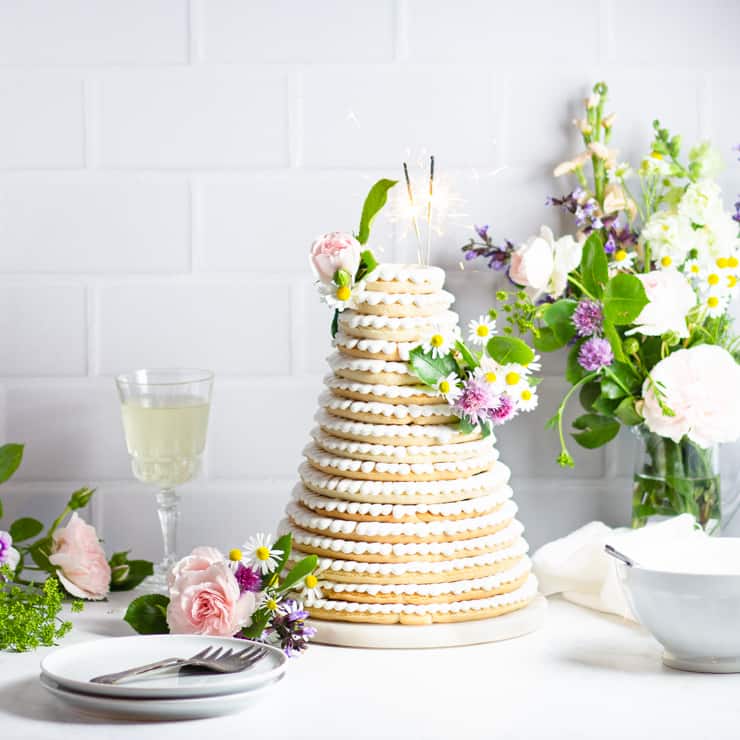
Disclaimer: Please note that some of the links below are affiliate links and I will earn a commission if you make a purchase using those links. I use all of the products included in this post and recommend them because they are products I personally love and trust. All affiliate links are clearly marked.
If you've been following me for any amount of time, you've probably heard about the 5 years I lived in Norway and the almost 2 years I worked in delicious little bakery nestled at the end of a fjord (Don't worry, I won't bore you with the details again... This time).
While we made many delicious cakes, like the suksessterte (a custard and almond cake) and hvit dame (a sponge cake filled with jam and whipped cream wrapped in marzipan), one of my favorites was the kransekake (pronounced KRANS-uh-kok-uh) if for no other reason than the sheer elegance of it.
Traditionally used for weddings, confirmations and holidays like Christmas and Norway's Independence Day, the kransekake is a towering cake made out of 18 crisp almond cookies "glued" together with icing.
It's the epitome of Norwegian baking: Simple, elegant and minimal. Don't worry, I won't tell your friends how easy this show-stopper was to make. 😉
Ingredients you'll need
For a treat this beautiful, you won't believe how few ingredients it actually requires. Seriously, we're talking just five ingredients in total. Here's what you'll need:
- Almond flour
- Powdered sugar
- Egg whites
- Meringue powder
- Water
A quick note about almonds and almond flour
Many traditional Norwegian kransekake recipes call for blanching almonds, peeling half of them and grinding them yourself.
If you want the full experience of making your almond flour from scratch, you can boil ½ lb of almonds for 3-4 minutes. The skin should peel right off. Spread the peeled almonds out on a baking sheet to dry overnight. Grind the peeled almonds with ½ lb of unpeeled almonds.
If you'd rather skip this step, you can simply purchase super-fine almond flour straight from the grocery store, which is available both with and without the skin.
A traditional kransekake dough would be made of equal parts blanched almond flour and whole almond flour. If you don't want to purchase both, either one will work; Just know that it will change the taste and color of the dough slightly (because the skin gives it a little extra flavor).
The kransekake in this post is made with 100% blanched almond flour.

Prefer to watch the process?
How to make a kransekake
First, make the kransekake dough.
Stir together the almond flour and powdered sugar. Add the egg whites and beat until the dough becomes a cohesive clump. It should resemble something similar to pie dough, but it won't be quite as smooth because of the almond flour.
The dough should be slightly sticky to the touch but shouldn't be so sticky that it won't pull away from your fingers. If it is, add almond flour one tablespoon at a time until it's just slightly tacky.
Second, form the kransekake rings.
Grease your kransekake rings with a cooking spray.
Grab small fistfuls of dough and roll them into strips on a (lightly) powder sugar dusted surface until they're roughly as thick as your index finger.
Gently press the dough into your kransekake ring mold (affiliate link), trimming the ends so that they just overlap. Gently press the ends together to seal.
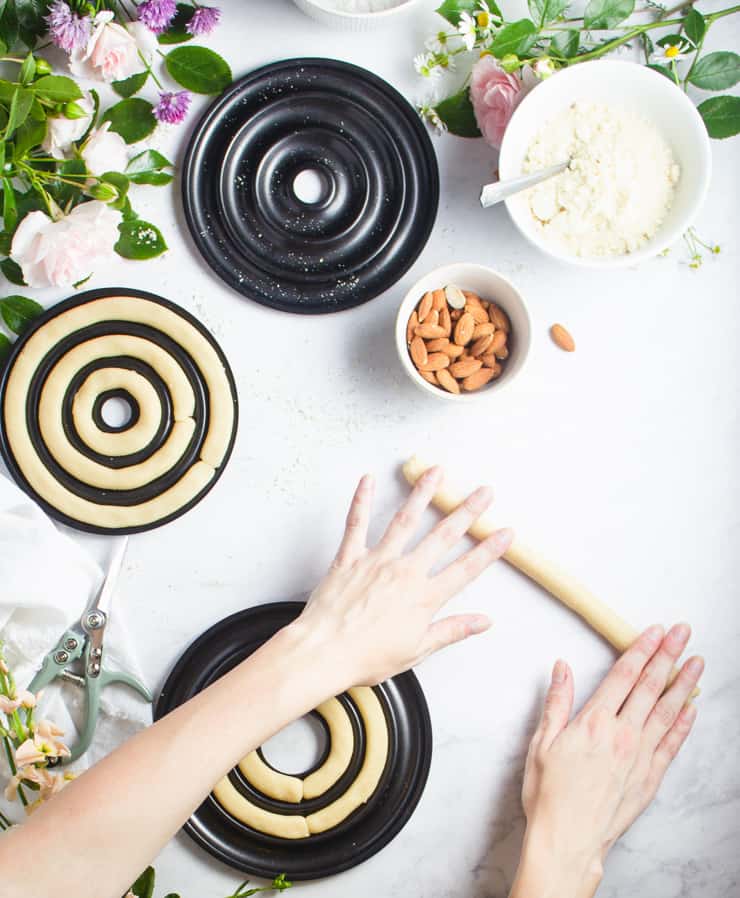
Third, bake the kransekake.
Bake at 400F for 8-10 minutes, or until just golden. Allow to cool in their rings.
To remove the kransekake from the mold, gently invert the pan. If they don't immediately come out, run a butter knife around the edge of the ring and invert again.
If you continue to have issues removing them, it may be because they undercooked. If this is the case, simply return them to your oven for 1-2 minutes before trying to remove them again.
Finally, make the icing and assemble the cake.
In a bowl, whip the meringue powder and water until frothy. Add the powdered sugar and whip until you reach a piping consistency.
Pro tip: Despite your best efforts, sometimes the rings don't come out perfectly even, which means your kransekake might lean if you're not careful. To avoid this, I like to stack my kransekake without icing so I can turn it as needed to ensure the rings stack up evenly and straight.
Fill a piping bag with the icing, pipe it onto the rings and stack.
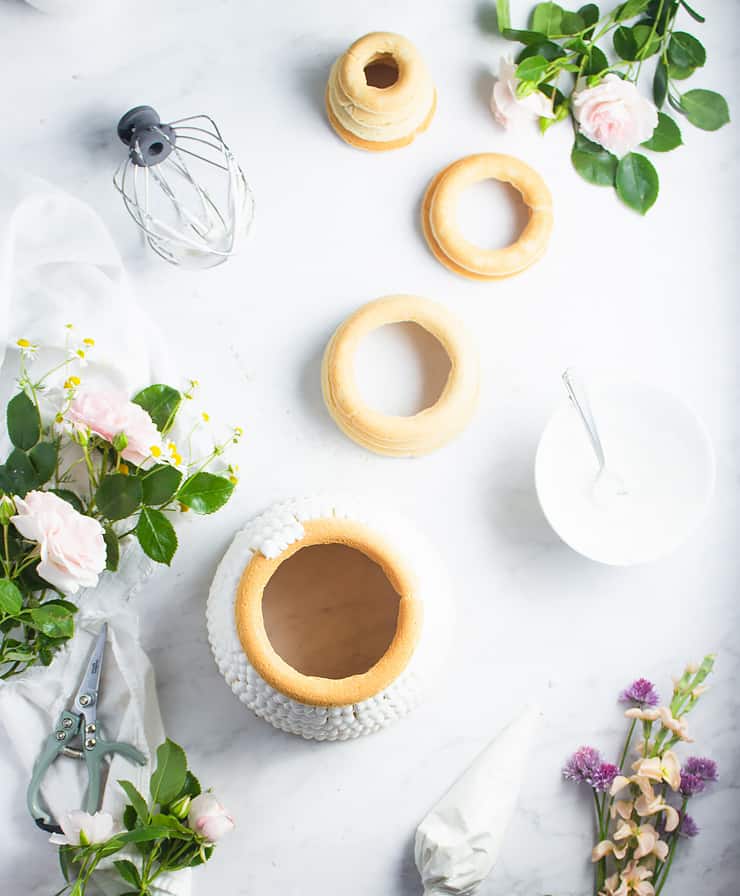
Garnish with fresh flowers, candies or just leave it plain. If you're using fresh flowers, check out my tutorial on safely adding flowers to a cake.

Kransekake variations
Don't feel like making a whole 18 ring cake? Kransekakestenger is a common variation that makes individual size pieces. Instead of forming the dough into rings, the dough is formed into 5" logs and baked on a baking sheet at 400F for 8-10 minutes or until golden. The kransekakestenger are then dipped in melted dark chocolate.
You can also make a 9 ring kransekake by halving the recipe. Just be sure you're filling the correct rings of your mold with dough, otherwise it won't stack correctly.
Tips for making a kransekake
- Purchase a kransekake mold: To ensure your kransekake don't spread while baking, you'll want to use a kransekake mold. This is the kransekake mold I use (affiliate link).
- Sticky dough: The dough should be slightly sticky to the touch, but if you find it's clinging to things, it may need some more almond flour. Add one tablespoon of almond flour at a time until it's just slightly tacky.
- Making a half batch: If you don't want to make a full size cake, you can halve the recipe, but be sure you're filling the right rings in your cake form.
- Sticking to the mold: Use a high quality mold and be sure to grease it with a cooking spray prior to adding your dough. If you find the rings are hard to remove once they've cooled, run a butter knife around the edge before inverting the pan. If they continue to stick, they made need to be baked a few minutes longer.
- Freezing kransekake: Unfrosted kransekake keeps well in the freezer. Simply places the rings in an airtight plastic bag. Thaw at room temperature until no longer frozen.
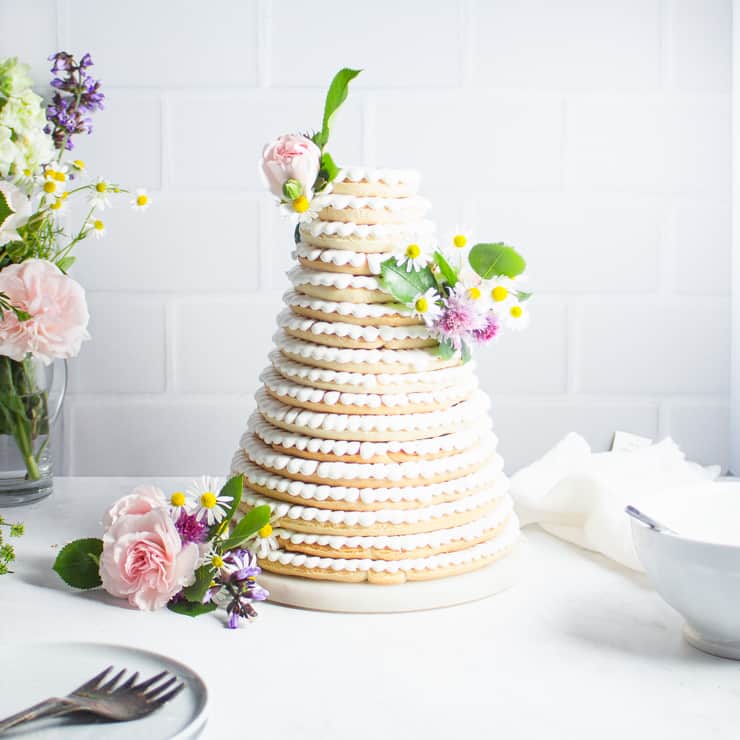
Frequently asked questions
Kransekake tastes like a lightly sweetened almond cookie.
The rings of the kransekake are traditionally pulled apart rather than sliced.
Kransekake is traditionally served by itself or with a cup of coffee.
Kransekaker is the plural form of kransekake. Kransekakestenger uses the same dough but rather than making a stacked ring cake, the dough is formed into individual cookie logs.
While you can make kransekake without a mold, it's very difficult to get the rings to come out even and uniform enough for stacking. The molds are well worth the investment.
Did you make this recipe? I’d love to hear how it went in the comments below. Better still, snap a photo and tag it on Instagram with #thesimplesweetlife. I love seeing your creations!
PrintRecipe
Kransekake Recipe
The kransekake is an elegant Scandinavian cake that's every bit as beautiful as it is easy to make. Learn how to make this delicious almond cake with just a few ingredients for your next big event.
- Prep Time: 30 minutes
- Cook Time: 10 minutes
- Total Time: 40 minutes
- Yield: 18 rings 1x
- Category: Dessert
- Method: Baking
- Cuisine: Norwegian
Ingredients
For the kransekake dough:
- 1 lb (450g) almond flour
- 1 lb (450g) powdered sugar
- 4 egg whites
For the icing:
- 1 tbsp. meringue powder
- 2 tbsp. water
- ¼ lb (115g) powdered sugar
Instructions
- Grease your kransekake rings.
- Stir together the almond flour and powdered sugar.
- Add the egg whites and beat until dough clumps together.
- On a powder sugar dusted surface, roll the dough into strips that are roughly the same thickness as your index finger.
- Gently press the dough into the ring, trimming the ends so that they just overlap. Gently press together to seal.
- Bake at 400F for 8-10 minutes, or until just golden.
- In a bowl, whip the meringue powder and water until frothy.
- Add the powdered sugar and whip until you reach a piping consistency.
- Pipe the icing onto the rings and stack.
- Garnish with fresh flowers, cookies or candies.
Notes
- Purchase a kransekake mold: To ensure your kransekake don't spread while baking, you'll want to use a kransekake mold. This is the kransekake mold I use (affiliate link).
- Sticky dough: The dough should be slightly sticky to the touch, but if you find it's clinging to things, it may need some more almond flour. Add one tablespoon of almond flour at a time until it's just slightly tacky.
- Making a half batch: If you don't want to make a full size cake, you can halve the recipe, but be sure you're filling the right rings in your cake form.
- Sticking to the mold: Use a high quality mold and be sure to grease it with a cooking spray prior to adding your dough. If you find the rings are hard to remove once they've cooled, run a butter knife around the edge before inverting the pan. If they continue to stick, they made need to be baked a few minutes longer.
- Freezing kransekake: Unfrosted kransekake keeps well in the freezer. Simply places the rings in an airtight plastic bag. Thaw at room temperature until no longer frozen.
Nutrition
- Serving Size: 1 ring
- Calories: 237
- Sugar: 30.9g
- Sodium: 14mg
- Fat: 8.8g
- Saturated Fat: 0.7g
- Carbohydrates: 35.4g
- Fiber: 2g
- Protein: 4.8g
- Cholesterol: 0mg
Keywords: kransekake, how to make a kransekake, kransekake oppskrift
If you liked this recipe, you might also like...




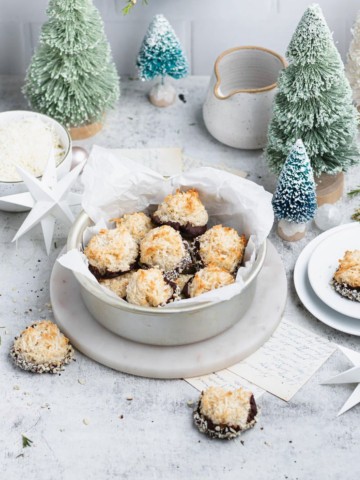
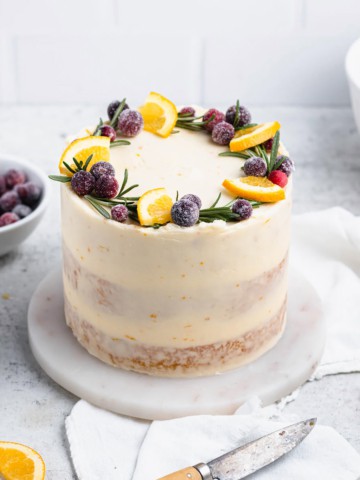
Sue Gregory says
I love the simplicity and elegance of this cake and your photos and flowers are gorgeous.
★★★★★
Jenny says
Can I lower the sugar to almond flour ratio? It's a little too sweet for me.
Dana says
Can you freeze the dough? Then bake later.
The Simple, Sweet Life says
Hi Dana! We used to bake and then freeze the kransekaker at the bakery I worked at, but I haven't tried freezing the dough prior to baking. This is something you can do with most cookie doughs so I imagine it would work just fine with this dough as well.
Darlene Cornell says
Can you use finely ground almonds instead of almond flour?
Claire | The Simple, Sweet Life says
Hi Darlene! As long as it's really finely ground, yes. 🙂 You can find a great tutorial on grinding your own almond flour here: https://foolproofliving.com/how-to-make-almond-flour/
Tone Crossman says
Yes you can use the ground almonds I do all the time.
Tone
1cheekymomma says
What size eggs do you use for the egg whites? And do you use your oven on convection or regular bake
Claire | The Simple, Sweet Life says
I use egg whites from large eggs and use the regular bake settings on my oven.
Alex says
How long after baking will this stay fresh?
Claire | The Simple, Sweet Life says
Hi Alex! A kransekake will last for about a week at room temperature. You can also freeze your un-iced rings in sealed plastic bags for up to 3 months.
Jana says
This was the worst kransekake recipe I've used. Sadly a waste of 1 lb almond flour. Despite multiple attempts the prepare baking rings, knowing this step is essential, they stuck fast every time. I tried baking longer, shorter, lower temp, crisco & flour, so much crisco, nothing worked. Crumbled disaster every time.
★
Mikayla says
This cake was beautiful and worth the effort to make, quite the treat for a special occasion I had this week!
★★★★★
Jenny says
This is such a beautiful cake! My mother-in-law is Swedish, and she loved your recipe. We are going to make it together this weekend!
★★★★★
veenaazmanov says
This is definitely so creative. Thanks for all the detailing to this recipe. A must try one. Simple yet so elegant.
★★★★★
Kristina says
This is such a cool looking cake- I have never heard or seen such a beautiful dessert and I can't wait to try it. Is there a special occasion these cakes are usually made? The video is really helpful to see how it's done, so thank you!
Claire | The Simple, Sweet Life says
Hi Kristina! Kransekake are traditionally served at weddings, confirmations, baptisms and on Norway's independence day (May 17).
Cathleen says
This is one of the most beautiful things I have seen all day! Thank you so much for sharing, I am definitely going to be making this this weekend! 🙂
★★★★★
Jamie says
Oh my, this cake looks absolutely gorgeous-looking and so delicious! The design and presentation make it so enticing and tempting! A perfect cake for such an enormous event! Loved it!
★★★★★
Jacqueline Debono says
I love the understated elegance of this cake. I've never had kransekake but going to order the mold so I can make it!
★★★★★
NATALIA says
My daughter and I can’t wait to make this! Just ordered the pans! One question… Do you cut this “cake” to serve or separate the rings like cookies after presentation?
Claire | The Simple, Sweet Life says
That's a great question Natalia! It's easiest to simply pull the rings apart and serve like cookies. When served as a wedding cake, the bride and groom pull the top ring and however many rings come off is said to be the number of children they'll have.
Ashley says
This is such a beautiful cake! I also love that you decorated it with fresh flowers. Sooo pretty!!
★★★★★
Sandra Kaye-Kjarum Seidel says
I'm sure it's going to be delicious because all of my research up to now highly recommends grinding your own almonds so that's my plan with your recipe : )
A couple of questions.... I have 2 kids getting married in NYC (I'm in Minnesota) and I want to bake them, freeze them & mail them. So should I decorate them before I mail them? Should I freeze them & mail them frozen? We'll be going out a few days before the wedding so I'm hoping to mail them before we leave. And I'm also thinking of doing a test run to see how the turn up there.
Thank you so much! I'm so jealous that you lived in Norway for 5 years... but we can still be friends! Hilsen
Claire | The Simple, Sweet Life says
Hi Sandra! First off, congratulations to the kids! And how lucky they are to have someone making fully from scratch cakes. That's a lot of work! You can absolutely bake and decorate the cakes, then freeze them for mailing. While we didn't mail cakes at the bakery I worked at, I've seen some Norwegian companies do it by stacking three sections of a kransekake and then nesting them one in the other so they can fit into a rectangular box. This should help minimize breaking and will also makes it easier to bubble wrap them. Here's an example from one of those companies: https://www.instagram.com/p/CE94lzDJ-Uo/?hl=en
Sandra Seidel says
THANK YOU from the bottom of my heart!!! I have been stumped by this & now I can bake (& ship) with confidence. I will report back on how everything went : )
★★★★★
Lise says
This recipe did not work. I tried making it twice. What a waste of ingredients! They came out completely flat. Terrible fail. Something is wrong with the recipe. Find another one, don’t use this one. 🙁
Claire says
Hi Lise! I'm so sorry to hear you had an issue with this recipe! Your kransekake dough should expand into the rings while it bakes but should remain largely flat on one side, which is ultimately what allows the rings to be stacked.
T RANDERS says
First time! It went well, maybe not great, but well. Followed full recipe and directions, all were great. I also read some of the comments and I worried about getting the rings out of the form. I should not have, they came out with only one having a small crack. Thank you icing. Many lessons learned:
1. We have a double-oven stove and I should have used the larger oven for better consistency baking the rings. Mine were many shades from golden to light/medium brown.
2. Being generous with the cooking spray on the forms paid off bigtime!
3. I was also generous with the icing and had to make a second batch - no problem.
4. I had so much trouble with rolling out the sticky dough, even with powdered sugar on hands and surface, I decided to deviate from the instructions and piped it in to the forms. This was much easier for me and worked great. Problem solved. Thank you for great directions and recipe, practice will make perfect for looks and they are already tasting good.
★★★★★